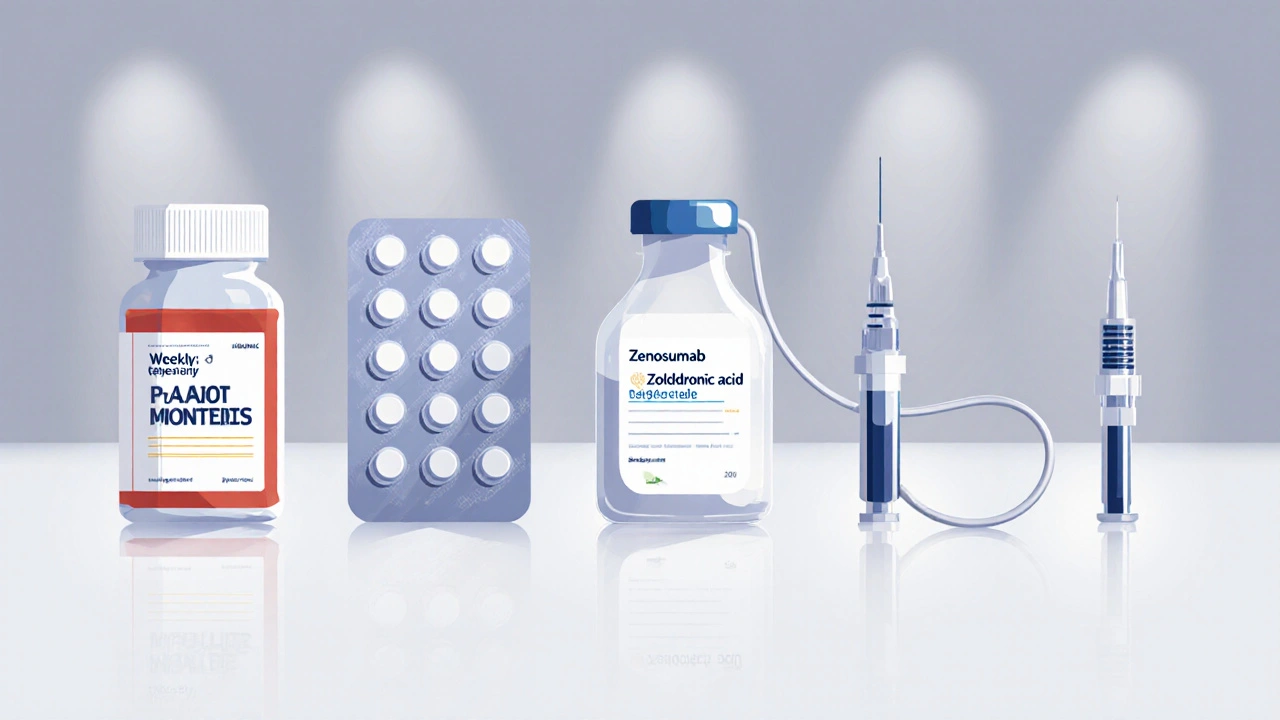Osteoporosis Treatment Comparison Tool
Key Takeaways
- Efficacy: Teriparatide shows highest BMD gains, followed by Denosumab and Zoledronic Acid
- Convenience: Fosamax and Risedronate offer weekly dosing; Denosumab requires biannual injections
- Cost: Fosamax is most affordable; Teriparatide is significantly more expensive
- Side Effects: Oral bisphosphonates may cause GI irritation; Denosumab carries infection risk
Osteoporosis threatens millions of adults by thinning bone and raising fracture risk. When a doctor suggests a prescription, the most common name you’ll hear is Fosamax. But you might also be offered other options that promise similar bone‑strengthening benefits with different dosing schedules or side‑effect profiles. This guide breaks down Fosamax and its main rivals, helping you weigh efficacy, convenience, safety, and cost before you commit.
What is Fosamax (Alendronate)?
Fosamax is a bisphosphonate medication that slows bone loss by inhibiting osteoclast activity. The active ingredient, Alendronate, is taken orally once a week, usually 70mg, with a full glass of water on an empty stomach. Patients must remain upright for at least 30minutes to reduce esophageal irritation.
Clinical trials show that weekly Fosamax can increase lumbar spine bone mineral density (BMD) by roughly 5-7% over three years and cut vertebral fracture risk by about 45%. Its efficacy depends on consistent adherence-missing doses quickly erodes the benefit.
Common Alternatives to Fosamax
While Fosamax dominates the bisphosphonate market, several other agents target the same pathway or use a different mechanism. Below is a quick snapshot of the most frequently prescribed alternatives.
- Risedronate - another oral bisphosphonate, available as a daily 5mg tablet, weekly 35mg tablet, or monthly 150mg tablet.
- Ibandronate - offered as a monthly oral tablet (150mg) or a quarterly intravenous infusion (3mg).
- Zoledronic acid - a once‑yearly IV infusion (5mg) typically administered in a clinic.
- Denosumab - a subcutaneous injection given every six months (60mg), working by neutralizing RANK‑L to reduce bone resorption.
- Teriparatide - a daily injectable (20µg) that actually stimulates new bone formation, reserved for severe cases.
- Calcium and VitaminD - essential supplements that support any osteoporosis medication but are not sufficient on their own.

Head‑to‑Head Comparison
| Medication | Efficacy (BMD % gain) | Dosing schedule | Administration route | Common side effects | Typical cost (AU$ per year) |
|---|---|---|---|---|---|
| Fosamax (Alendronate) | 5-7% (3yr) | Weekly 70mg | Oral | Gastro‑esophageal irritation, atypical femur fracture (rare) | ≈$150 |
| Risedronate | 4-6% (3yr) | Weekly 35mg or monthly 150mg | Oral | Upper‑GI upset, esophagitis | ≈$180 |
| Ibandronate | 3-5% (3yr) | Monthly 150mg (oral) or quarterly 3mg (IV) | Oral or IV | Flu‑like symptoms (IV), GI irritation (oral) | ≈$200 |
| Zoledronic acid | 6-8% (3yr) | Yearly 5mg | IV | Acute phase reaction (fever, muscle aches) | ≈$300 |
| Denosumab | 9-10% (3yr) | Every 6months | Sub‑Q injection | Skin reactions, rare infection risk | ≈$600 |
| Teriparatide | 12-14% (2yr) | Daily 20µg | Sub‑Q injection | Nausea, dizziness, high calcium | ≈$3,500 |
How to Choose the Right Medication for You
Decision‑making is rarely about “the best drug” in isolation. Consider these three pillars:
- Medical suitability. Impaired kidney function (eGFR<30mL/min) disqualifies most oral bisphosphonates; a physician may prefer Denosumab or IV options. History of esophageal disorders also steers patients away from Fosamax or Risedronate.
- Lifestyle & adherence. A weekly pill fits busy schedules, but if you often forget doses, a once‑yearly infusion (Zoledronic) or a six‑month injection (Denosumab) reduces the chance of missed treatment.
- Cost & insurance coverage. In Australia, the Pharmaceutical Benefits Scheme (PBS) subsidises many bisphosphonates, but Denosumab and Teriparatide may require private fund approval.
Ask yourself: “Can I stay upright for 30minutes after a weekly tablet?” If the answer is no, an IV or injection route might be a better fit.
Practical Tips for Taking Bisphosphonates Safely
- Take the medication with a full glass of plain water (no juice or coffee).
- Wait at least 30minutes before eating, drinking anything other than water, or taking other meds.
- Stay upright or sit up straight during that waiting period; lying down can increase esophageal irritation.
- Consider a calcium‑rich breakfast (e.g., fortified orange juice) after the waiting window to aid absorption of other supplements.
- If you experience persistent throat pain, discuss a switch to a less irritating alternative such as IV zoledronic acid.

Pros and Cons at a Glance
| Medication | Pros | Cons |
|---|---|---|
| Fosamax (Alendronate) | Proven long‑term data, affordable, weekly schedule. | GI side effects, strict fasting rules. |
| Risedronate | Flexible dosing (daily, weekly, monthly). Less gastric irritation than Fosamax for some patients. | Still requires fasting; monthly tablets are larger. |
| Ibandronate | Monthly oral option reduces pill fatigue; IV form bypasses GI tract. | IV infusion can cause flu‑like symptoms; oral form still needs fasting. |
| Zoledronic acid | Once‑yearly dose ensures perfect adherence; high BMD gain. | Needs clinic visit; possible acute‑phase reaction. |
| Denosumab | Strong BMD increase; convenient six‑month injection. | Higher cost; rare infection risk; must not miss injection. |
| Teriparatide | Stimulates new bone; best for severe osteoporosis. | Daily injection; expensive; limited to 2‑year course. |
When to Re‑evaluate Your Treatment
Bone‑density testing (DXA) is usually repeated every 1-2years. If the latest scan shows less than a 3% increase in lumbar spine BMD or a new fracture, it’s time to discuss a switch. Additionally, any new gastrointestinal symptoms, persistent muscle pain after an IV infusion, or unexpected drops in calcium levels should trigger a medication review.
Frequently Asked Questions
Can I take Fosamax and calcium supplements together?
Yes, but wait at least 30minutes after the Fosamax dose before you take calcium. Calcium can bind to the tablet and reduce absorption if taken too soon.
What if I forget a weekly Fosamax dose?
Skip the missed dose and resume the regular weekly schedule. Do NOT take a double dose to catch up, as that can increase GI irritation.
Is Denosumab safe for people with kidney disease?
Denosumab does not rely on renal clearance, making it a preferred option for patients with moderate to severe kidney impairment, provided calcium and vitaminD levels are monitored.
Why do some patients develop flu‑like symptoms after zoledronic acid?
Zoledronic acid can trigger a short‑term immune response called an acute‑phase reaction. Symptoms usually resolve within 48-72hours and can be eased with acetaminophen.
How long can I stay on Fosamax?
Many clinicians recommend a “drug holiday” after 5years of continuous use if BMD has plateaued and fracture risk is low. Discuss the timing with your doctor.
Jake TSIS
October 7, 2025 AT 14:44Akintokun David Akinyemi
October 9, 2025 AT 10:07Jasmine Hwang
October 11, 2025 AT 05:30katia dagenais
October 12, 2025 AT 07:27Josh Gonzales
October 13, 2025 AT 12:37Jack Riley
October 14, 2025 AT 23:49Jacqueline Aslet
October 15, 2025 AT 17:01Caroline Marchetta
October 17, 2025 AT 07:16Valérie Siébert
October 17, 2025 AT 08:41Kaylee Crosby
October 19, 2025 AT 00:37Karen Ryan
October 20, 2025 AT 01:16Terry Bell
October 20, 2025 AT 22:27Lawrence Zawahri
October 21, 2025 AT 05:15Benjamin Gundermann
October 21, 2025 AT 11:43Rachelle Baxter
October 23, 2025 AT 10:58